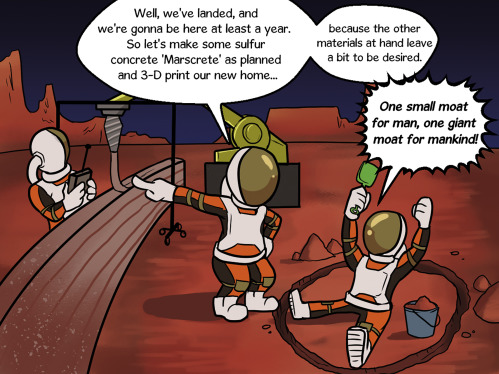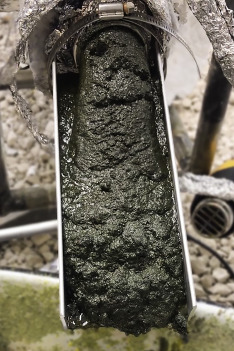In the recently published ‘Martian Material Sourcing Challenges Propel Earth Construction Opportunities,’ authors Matthew Troemner and Gianluca Cusatis tackle the ongoing and fascinating subject of colonizing Mars. Painting a very realistic picture of what it would be like to arrive there, Troemner and Cusatis explain that in virtual desolation, astronauts would need to take nearly all necessities with them. And while regolith would be available as a construction material, obviously there is not much else; in fact, it is promising that regolith in itself is available as it could prove to be extremely valuable. There are also plentiful supplies of sulfur compounds.
With the idea that visitors to Mars will be staying for long periods of time rather than just a long weekend, the researchers realize that there must be the real potential for an ‘extended habitat.’ In line with NASA’s 3D Printed Habitat Challenge ideal, they also state that a habitat should be able to withstand the elements for a year (365 days—an Earth year). This means consideration to self-weight and pressure differential, indefinite duration needs, and consideration for unexpected and sometimes negative events—like fire. There must also be consideration for:
- Martian winds
- Sand-dune buildup
- Thermal undulation
- Meteorite impact performance
“With such durability, the habitation structure(s) will arguably be the most substantial building component and, therefore, critical of local, or in situ, resource utilization,” said the researchers.
Regolith means that astronauts have a sand-like material on hand, made mostly of silicon dioxide, along with iron oxides and aluminum oxide. After that comes calcium oxide, magnesium oxide, sulfur trioxide, sodium oxide, and trace minerals. Even more interesting, however, is the concept that upon arrival, autonomous robots, having no use for their space vessel, could recycle the parts and materials into construction resources.
Back to regolith, however: 3D printing is expected to be fully viable as it needs no added binders for construction. The authors point out though that it is very energy-intensive, with temperatures over 1,100°C required. Sulfur concrete may ‘pose a new use case,’ however, as it is found in such good supply. The researchers also remind us that on Earth, sulfur concrete is not very useful due to inherent weakness, lack of fire resistance, and odor. On Mars though, these characteristics are heavily minimized.
For 3D printing, ‘marscrete’ is expected to promote large-scale 3D printing for a planetary habitat. This material is completely temperature-dependent though, with the flow of sulfur and regolith heated and then mixed.
“Such material is easily deposited; however, it does not hold its form well until an outer layer of solidified material develops,” state the researchers. “Few in situ resources can be added to address this issue; however, pulling from the spacecraft may be a solution.”
Construction will take substantial processes in automation along with groundbreaking (literally) new use of materials.
“Despite lofty headlines of future Martian colonies, the technology and materials currently under development may play an even earlier, and greater, role here on Earth,” conclude the researchers.
The topic of colonization on Mars is popular, and it is easy to see why—just on a topical basis—as the idea of living on the faraway planet is fascinating to most Earthlings. Materials for habitats are a huge consideration though, and researchers continue to work on simulation resources from Martian soil to other exploration regarding moon dust and robotic manufacturing.
What do you think of this news? Let us know your thoughts; join the discussion of this and other 3D printing topics at 3DPrintBoard.com.
[Source / Images: ‘Martian Material Sourcing Challenges Propel Earth Construction Opportunities’]
Subscribe to Our Email Newsletter
Stay up-to-date on all the latest news from the 3D printing industry and receive information and offers from third party vendors.
You May Also Like
Air Force Awards Fortius Metals $1.25M to Qualify 3D Printing Wire for Hypersonic Applications
AFWERX, part of the US Air Force Research Laboratory (AFRL), awarded a Direct-to-Phase II Small Business Innovation Research (SBIR) contract worth $1.25 million to Colorado’s Fortius Metals, to accelerate qualification...
US Air Force Awards JuggerBot $4M for Large-format Hybrid 3D Printing
Large-format 3D printer manufacturer JuggerBot has received a $4 million grant to develop a large format 3D printer, courtesy of the Under Secretary of Defense, Research and Engineering Manufacturing Technology...
Where Have All AM’s Unicorns Gone?
In the rapidly evolving world of 3D printing, startups valued at over a billion dollars, known as unicorns, once seemed as fantastical as the mythical creatures themselves. While a few...
How My Childhood Fascination with Planes Led to Investing in 3D Printing
My fascination with aerospace started young, and I started studying planes–identifying them in the sky and learning everything I could about how they work. Fast forward to my first week...


































